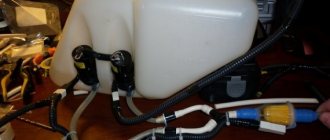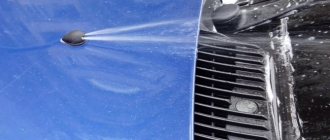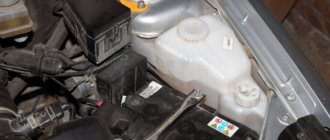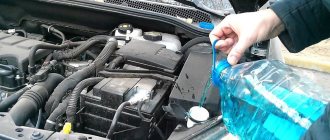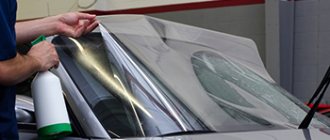How to drain fluid from the washer reservoir correctly and without problems
Every car has a washer reservoir containing a special fluid.
This can be water or a special solution, prepared with your own hands or purchased at a car store. In any case, it needs to be changed.
The reasons for this may be different, we will also talk about them. We will also tell you in an accessible form how to change the washer fluid.
Why do you need to drain the washer fluid?
Why do many motorists decide to change the washer fluid in the washer reservoir? What pushes them to take such a step? In fact, there are several reasons why every motorist should think about the need to carry out such a procedure. Even experts recommend removing the remaining summer fluid from the washer reservoir. The reasons may lie in the following:
- Using ordinary water in winter risks freezing in the car system. The situation will not only be unpleasant, but also dangerous for the car, because when water expands it can damage the tubes, pump, pipes and sprinklers.
- Using tap water is an even more disastrous situation. You should try not to pour tap water into the system, since when used for a long time, sediment will form, which reduces the efficiency of the nozzles and causes clogging of the tubes.
- Anti-freeze products are often counterfeited, and no one is safe from purchasing such a product. When using it, the benefit will be minimal, but it can cause harm to health. If an unpleasant odor is detected, which is the first sign of a low-quality antifreeze, it is necessary to immediately change the working fluid.
- When adding fluid from another manufacturer, a chemical reaction may occur inside the system. The result may be a jelly-like substance.
Whatever problem you encounter, in any case you need to know what to do and how to drain this working fluid.
Washer reservoir location
To replace washer fluid, you need to know where the reservoir is located - this is logical. This part is located under the hood. To get to the reservoir, you need to pull the lever that opens the hood.
You can usually find it near your left knee by the image of an open hood on the handle. Then you can get out of the car and open the hood, do not forget to fix the lid using a special device.
Now we have to find where the tank is located. To do this, you need to stand in front of the car and look at the left side of the engine compartment. In the vast majority of cars, the part we need is located behind the optical element, although it can also be behind the radiator. The windshield washer reservoir looks like a small transparent or white plastic container. Its volume can vary from 3.5 to 5 liters.
One of the identifying marks of this part is the lid, which is often painted blue or light blue. Sometimes the cover may be black or yellow. Usually it depicts glass on which washer is sprayed.
How to drain the liquid
We found out where to look for the vessel that needs to be emptied of liquid, all that remains is to figure out how to drain the water from the washer reservoir. The situation is ambiguous, since all cars have different design features, so this process may differ depending on the car model.
The easiest way to pump water out of the washer reservoir is for owners of cars that were produced back in that century. Back then, manufacturers didn’t particularly strive for high aerodynamic performance, so the engine compartment could be called free. It will be easy for owners of such cars to remove the washer pump, dismantle the reservoir and calmly drain the remaining fluid.
Modern cars have a narrow engine compartment, in which there is no free space and all the parts are located very compactly, one might say, right next to each other. Manufacturers, in pursuit of improved aerodynamic performance, create the most unexpected designs and shapes. Therefore, it can be difficult to get to the tank.
Among such modern cars, the easiest way to drain the water from the washer reservoir is on the Priora and Kalina. Here the containers are located in accessible places. With other cars it's not so simple. In some cases, you even have to dismantle the wheel so that you can get to the treasured container. Other car owners are forced to remove the bumper. True, you can avoid such difficulties if you know some tricks that we will now reveal.
The method that we will describe can only be used with a small amount of liquid in the tank. Its essence lies in the use of a standard washer pump. It is necessary to turn it on and allow the liquid to be pumped out of the container. It should not be operated for long periods of time as the electric motor may fail. Therefore, this method cannot always be used. If the container is very full, you will have to forcefully pour out the liquid in any possible way.
There is another universal method. To implement it, you need to find a thin, preferably transparent hose. With its help, the washer reservoir can be quickly emptied. But liquid is also present in pipelines. You will need an air compressor to empty them. We disconnect the tube from the pump and supply compressed air to it. The pressure must be moderate, otherwise the system may be damaged.
Emptying the car washer reservoir of working fluid is not the most difficult task. This work can be done independently without outside help with minimal time investment.
Frequently asked questions from car owners
How and where to add windshield washer water?
- In the cabin, open the hood handle
- Finally open and secure the hood
- Unscrew the large cap on the windshield wiper reservoir, the one without wires
- Pour liquid into the tank. Approximately five liters will fit in this canister
What liquid is recommended to be poured into the washer reservoir of the VAZ 2114?
Different times of the year require different windshield wipers to clean glass. In winter, at low temperatures, it is recommended to fill in an antifreeze additive. It will protect the tank from freezing, and with it the parts of the windshield wiper system will not burst from temperature overloads. In summer, it is recommended to add a cleaning additive to the water. During this period, abundant sediment of exhaust gases, oils, and car paint care products accumulates on the glass.
Advice: for the best effect, you should first pour the additive into the tank, and only then ordinary water. This will allow the liquids to mix better.
How can you heat the windshield wiper reservoir in winter?
Option one: homemade
Materials: 1 meter of 8 mm copper tube, 2 meters of 8 mm wrapped hose, 2 reservoir cuffs and 4 clamps.
Heating installation technology: two holes for cuffs are drilled in the tank lid. A copper tube is already inserted into them, which must be given the reliefs of the tank in advance. At the exit, the tube should be in a horizontal position. The hoses are connected to the throttle body and thermostat.
Option two: in the form of a coil
Technology: the same copper tube as in the first option. But here it is given the shape of a coil using a soldering iron. The resulting coil is not attached, as usual, to the tank instead of a lid. It is soldered to a textolite plate. Afterwards, the homemade coil is installed in the tank as low as possible so as not to interfere with the liquid level sensor.
Holes for the thermal device are cut using a soldering iron. This way they turn out neat. Their diameter is 3 millimeters. The edges should be lubricated with sealant. The best fastening for the device is stainless steel screws. When installing, they should be heated with a soldering iron - this way they will be better fixed in the windshield washer reservoir.
Option three: ready
This is a ready-made heating system for the Geyser tank washer. Operating principle: as it passes through the coil, the temperature of the coolant begins to rise. Accordingly, the degree of liquid in the tank also increases.
Price is an issue
You can find out how much a VAZ 2114 washer reservoir costs in local stores in your city, or through an Internet search engine. The average price in online stores for a windshield washer reservoir is 250 rubles.
When we press the windshield washer lever, a small motor under the hood of our car drives an equally small pump. As a result of this, the washer fluid from the reservoir is pumped into the washer nozzles - these are small protrusions with holes on the hood, directed towards the windshield. It is from there that, under the pressure created by the pump, the “washer” or, as it is also called, “anti-freeze” sprays. Let's find out what to do if the washer suddenly runs out. Where can we find the washer reservoir under the hood and where can we fill in the new anti-freeze agent?
Read more: What volume is needed for a 12 subwoofer
Firstly, during the autumn-winter-spring seasons, it is best to always have a supply of washer fluid in the trunk of 2-4 liters. It’s very unpleasant to find yourself in slushy weather without it and without the prospect of finding an auto shop within the next few kilometers. The second thing you need to know is that there are summer and winter washer options. The first is much cheaper, but freezes at low temperatures, while the second usually remains liquid down to -30 degrees. Therefore, it is necessary to choose one or another type of anti-freeze based on weather conditions. Remember that in some cases, frozen washer fluid (especially poor quality) can lead to destruction of the nozzles and their subsequent replacement.
So, where do we fill the antifreeze and where is the washer reservoir located in our car? The answer to this question is quite simple. In 99% of cases, the washer fluid reservoir is located under the hood. Therefore, the first thing to do is to pull the hood release lever (as a rule, it is located at the level of the left knee with the image of an open hood on it). Then we go out, lift the hood lid and fix it using a special holder lever - you can also find it without any problems - usually it is inserted into the latch on the raised hood lid itself.
Next, we look for where the washer reservoir is located. Standing in front of the car, look at the left side of the engine compartment (relative to you); in almost all car models it is located immediately behind the headlight. The washer reservoir is a white or translucent tank with approximately 3.5-5 liters of anti-freeze.
And its lid will help us more specifically and accurately identify the washer reservoir. It is often blue or cyan in color, but can also be yellow or black. And it shows a windshield with a splashing washer. And we can make sure that this is the tank we need by assessing its contents - after all, since we have run out of glass washer, it should be empty (except in rare cases of clogged nozzles or a breakdown of the motor or pump of the washer system).
So, we have decided where to fill the washer fluid. You simply open the lid (more often it just snaps on, less often it unscrews) of the washer reservoir and the cap of the bottle with a new anti-freeze agent and begin to carefully pour in the contents of the bottle, trying not to splash the washer on other units and parts. If you suddenly splash something, then look to see if there are any wires coming off of it. If not, then everything is fine. It is also undesirable for the washer to get on the drive belt - this (however, in very rare cases) can worsen its performance.
Removing the washer reservoir for Renault Logan
Renault Laguna 1, washer reservoir, buy a new one or glue the old one
Conclusions As you can see, the procedure for removing and finding the tank is quite simple. The situation is simplified by a ready-made mixture, which, however, would not hurt to test at home by placing a small amount in the freezer - counterfeits are quite common.
The tank cracked in the winter and forgot to drain the water. How to remove the Renault Logan washer reservoir? IN 1. 1. Open...
Between the hood compartment and the windshield, under a protective decorative plug. What to do if the washer cap does not hold well?
What to do if, during the replacement process, it turns out that the windshield washer does not work - the answer to this question is here! To prevent this from happening to your Renault Logan, you must adhere to the following simple rules:
Simply rubbing dirt will result in numerous scratches on the windshield. There are several reasons for the malfunction: To prevent this from happening to your Renault Logan, you must adhere to the following simple rules: Do not forget to add fluid. Before frost, change the water to a non-freezing liquid, checking that its temperature corresponds to that typical in your region.
Change the fluid In preparation for the cold season, drivers change the washer fluid. If a concentrate is used, it is diluted before pouring into the tank.
Sometimes the rule is ignored and an undiluted solution is poured into the system, believing that it will mix with water inside.
However, it is not known how much water is there - the concentration risks being too weak and leading to the freezing of the liquid at sub-zero temperatures. It is better to completely pump out the water, and only then fill in the solution diluted in the required proportion.
The situation is simplified by a ready-made mixture, which, however, would not hurt to test at home by placing a small amount in the freezer - counterfeits are quite common.
If the liquid is not frozen after freezing, then you can safely use it. Sometimes they remember the need to change the fluid only when the thermometer reaches minus at night, which risks freezing.
Moreover, adding concentrate will not always lead to the melting of the liquid inside. Therefore, before the onset of cold weather, it is important to remember about replacement. Causes of device malfunction Of course, not all problems are the fault of car owners. If the Renault Logan system was replaced quite recently, then failures may occur due to poor adjustment of the tank.
Location of the tank under the hood of Renault Logan
On different versions of Renault Logan, the tank is located in different places.
Renault Logan 1st generation
It is located in the engine compartment on the passenger side. Between the hood compartment and the windshield, under a protective decorative plug.
The location of the washer reservoir is indicated by a red arrow
Reservoir lid is open
Washer reservoir without decorative plug
Renault Logan 2nd generation
The washer reservoir on the second generation Renault Logan is located on the left, closer to the edge of the engine compartment (where the passenger is). In the same place as the first generation, but a little to the left.
Close-up view of the tank lid
The arrow marks the filler plug of the washer reservoir on the second generation Logan
Video “How to seal a container with plastic?”
Detailed instructions for repairing the tank are presented in the video below (the author of the video is Vladislav Semshchikov).
The windshield washer reservoir is a white plastic canister that holds windshield cleaning fluid. Let's take a closer look at where the washer reservoir is located and what it is.
Location of the washer reservoir VAZ 2114
The windshield washer reservoir is located on the left, under the hood. On the right side of it is the engine. The windshield washer reservoir canister is only an element of the general group.
The windshield washer system consists of:
- Canister tank washing glass
- Washer jets
- Pressure pump
- Hose between pump and jet
- Tee
- Liquid level sensor
- Mounting bracket and tank plug
- Vinta
Washer reservoir design
Windshield washer reservoirs are unified and consist of the following main structural elements:
- A housing used to store coolant and mount other parts. The case has a rear neck with a screw cap.
- A pump that supplies fluid to the injectors.
- Many tanks have a washer fluid level sensor.
- Fastening the tank (brackets and clamps).
The tank body on all modern cars is rigid; it can also be solid (one plastic part) or composite (two molded plastic parts that can be disassembled).
The tanks also contain various structural parts, listed below:
- Filler neck into which the screw cap is installed. The lid must be screwed tightly to avoid loss of liquid. However, the lids are often provided with plastic bridles for safety.
- The screw cap itself.
- Holes for mounting a liquid supply pump.
- Hole for mounting a liquid level sensor.
- Washer fluid level marks and vertical grooves.
When repairing a tank, pumps are installed through holes with inserted rubber bushings. The pump installed on top can be fixed with a plastic cap nut. The pumps at the bottom of the tank are held in place by the elasticity of rubber bushings. The tanks are attached to the body either using brackets molded on them, or using separate baskets or clamps.
In the first case, the tank is secured using holding brackets, and in the second, it is inserted into a metal basket or secured to a clamp installed on the car body. The level sensor will notify you in time that the liquid is running low. They are located at the top of the reservoir and connect to an indicator on the car's dashboard.
How to change a plastic tank
To replace or install a new plastic tank, you need an algorithm of five simple steps:
- Lift the hood up
- We drain the remaining liquid from the tank into a separate container, sequentially removing the pipes on the motors. Don't forget that they have polarity: white is positive and black is negative.
- Having freed the tank, we take out the liquid level sensor
- We take out the tank itself, carefully but forcefully, pulling it up
- Using a straight-slotted screwdriver, remove the electric motors
Removing windshield washer motors for VAZ 2114
Read more: Ford rear suspension replacement
This is the procedure for removing the tank. If you need to install a new windshield washer reservoir, the steps will be the same, but in reverse order. If during installation difficulties arise with the electric motors, it means that the rubber seals are interfering with them. In such a situation, regular soap will help.
After installing the tank and electric motors, there may be a problem with installing the injector pipes. They are difficult to fit onto the motors. The process will be easier if you heat the tip of the tube with a flame from a regular lighter. When heated, the walls of the pipes will become softer and more flexible.
Electrical tape is suitable for tightly fixing the motor. It should create additional volume.
Removing the windshield washer electric pump Renault Logan
The question is simplified if you purchase a ready-made mixture, which, however, would not hurt to test at home by placing a small amount in the freezer. After all, quite often there are fakes in this market segment. If the liquid does not freeze after freezing, then you can safely use it for your car. There are often cases when the need to change the fluid is remembered only when the thermometer reaches minus at night.
This risks freezing. Moreover, in this case, adding concentrate will not always lead to melting of the liquid inside. Therefore, before the onset of cold weather, it is important to remember that it must be replaced in a timely manner.
Finding the washer reservoir
Everything is very simple, in almost all cases the washer reservoir is located under the hood. This is done to prevent the liquid from flowing through the entire machine. After all, then you would need a very powerful pump that could create the necessary pressure. But there is no need for such reasons; the washer reservoir is always located under the hood, very close to the windshield.
First you need to open the hood, the button is usually located next to the left knee, and the car part of the same name is drawn on it. We get out of the car, lift and fix the lid. To do this, we need a special locking lever; it is usually attached to the bottom of the hood.
Now you need to look around and find the washer reservoir. If you are facing the car, then you need to look to the left side of the entire structure and take a closer look at the place next to the headlight. It is always white in color and has a screw top to prevent spillage. The tank can hold from three to five liters, so it is very easy to find among the other parts in the engine compartment.
If there is no success, then take a closer look at the blue or cyan dot. This is the color of the washer reservoir cap. Sometimes it can be yellow or black. In the latter case, the search becomes more complicated, then you need to continue looking for the white tank. After studying our instructions, you will find the washer reservoir very easily, in a few seconds. There are no car models where this part is hidden very deeply. She is always visible and has a certain color.
Instructions for replacing and repairing the tank
Replacing the washer reservoir is usually done as a result of its failure, which cannot be repaired. In particular, if the CP is cracked and it is no longer possible to restore its integrity.
Using the example of a VAZ 2114 car, let’s look at how to remove the washer reservoir:
- First open the hood. Before removing the BO, it is necessary to drain all remaining liquid from the container. If the liquid level in the container is high, then unscrew the cap of the washer reservoir, this will reduce the pressure in the system.
- Then the BO is removed from the grooves; to do this, it can be pulled up, and placed in such a way that you can easily dismantle the electric motors.
- You need to disconnect the contacts from the motors, as well as the water supply pipes.
- Next, the electric motors are removed from the container body - for this you can use a regular screwdriver to pry them off (the author of the video is the menstimecom channel).
As you can see, there is nothing complicated in removing BO. It is much more difficult to repair the washer reservoir. If the container is cracked, it is not a fact that it can be repaired, since everything depends on the size of the crack and its location.
Read more: Lada Largus radiator removal
If you don’t know how to seal the washer reservoir, then you have several options:
- For gluing, you can use special glue or cold welding. Before applying material to a crack, the BO must be thoroughly washed, and the area to be patched must also be degreased. Glue or cold welding is applied to the crack, while it is necessary to grab a few more millimeters from each edge of the crack. Depending on the type of glue and cold weld, the waiting time for the material to dry can range from 30 minutes to several hours.
- If the crack or hole is small, you can try to treat it with regular sealant. In this case, the repair procedure looks similar - the surface is first washed and then degreased. A certain amount of sealant is applied to the hole, which should completely fill the crack and the space around it.
- Another option that is best suited for larger cracks is the use of special plaster tape. It is also installed on a degreased surface, but before installation the tape should be coated with epoxy, and the material should be applied in several layers until all the cracks are closed.
- If all these options do not help you, then you can use a soldering iron or wood burning machine. With the help of these devices, the structure of the container is softened, which makes it possible to restore its integrity if the damage is minor. Additionally, after treatment with a soldering iron, the damaged area of the BO can be covered with cold welding.
Photo gallery “Removal and repair of the container”
Where is the windshield washer reservoir located?
The cleanliness and transparency of the windshield directly affect the safety of movement on the road and sufficient visibility for maneuvering. As soon as snow begins to fall, and dirt gets onto the glass from under the wheels of oncoming cars, the windshield washer comes into operation, cleaning its surface from dirt, dust and other foreign particles. Today we will talk about what a windshield washer is, why it is needed, and also go into detail about the design of the washer reservoir.
Principle of operation
When considering such an element of car systems as a windshield washer, the question arises as to which category of systems it can be classified into. On the one hand, it is clearly visible that it belongs to comfort systems. This comfort obviously means providing good visibility for the driver and passengers and eliminating the need to constantly go outside and wipe the front glass yourself.
However, many manufacturers and engineers seriously call the washer system a safety system. Why is this so? The fact is that the quality of visibility directly affects the safety of the driver and passengers. An oncoming car or obstacle not noticed in time can lead to sad consequences that you don’t want to think about again.
But what does the washer system consist of and how does it work? What makes it work? Its main element is the washer reservoir, the capacity of which is about 3–5 liters. The washer reservoir is installed in the engine compartment, as a rule, as far as possible from the engine and other heated parts, in order to avoid damage to the material and its melting.
How to change windshield washer fluid in a car
So, you have purchased anti-freeze windshield washer fluid, and you need to pour it into the reservoir. This procedure is not complicated, and you do not need to go to a service station - you can do the draining and filling yourself.
If you have never done this before, remember: the washer reservoir is located under the hood of the car (look for it on the left hand side in the headlight area). It is a small translucent/white container with a capacity of up to 3.5 liters with a blue, cyan, black or yellow lid, which can depict a windshield with a spraying washer.
Detailed view
The washer bull is precisely the element on which several characteristics of the washer system depend. Firstly, this characteristic is volume, that is, the amount of liquid that can be poured at one time. Obviously, the larger the specified value, the more you will be able to fill.
Typically, you can fill about 4 liters of liquid into the washer reservoir. However, in some cases this value can vary from 2 to 8 liters, depending on the type of car and its size.
The second characteristic that the washer reservoir has is the material from which it is made. On older cars, tanks were made of stainless steel: this material is practically not subject to corrosion, but at the same time is quite durable and resistant to physical influences.
However, time does not stand still, and a washer reservoir made of metal can only be found on cars of the last century. Modern polymers are in no way inferior to metal and even surpass it in most parameters. In addition, the polymer is stretchable. This allows the tank to contain even frozen liquid and not crack as its volume increases.
The polymer from which the windshield washer reservoir assembly is made has fairly thick walls, but at the same time remains lightweight. The thick walls are made this way for the reason that the weight of four liters of washer fluid exceeds four kilograms, which is quite an impressive amount. Thick walls are not so susceptible to deformation, and therefore will not lose their shape, even if you have to drive on a bumpy road.
As for the filler neck, it is usually closed with a screw-on cap. Some models have a spout that extends outward and allows you to pour fluid more quickly and accurately without spilling it on the engine and wiring.
Frequent unit malfunctions
The container for antifreeze liquid does not require maintenance during vehicle operation, but malfunctions may occur that require repair or complete replacement of the product. It is necessary to contact car service specialists in the following situations:
- If cracks have formed in the tank body.
- The seal of the product was broken and leaks began to form.
- The threaded connection is not tight enough, which can also lead to leaks.
- If the water freezes, the unit in this case becomes completely inoperable.
- Electric motor failure. Such a malfunction leads to a decrease in pressure, and the product will reach the nozzles in insufficient quantities or will not flow at all.
Add antifreeze to the windshield washer reservoir.
In case of accidents, vibrations or mechanical impact, the structure may completely collapse. If the washer reservoir has burst, it may need to be completely replaced. All types of faults are divided into two main categories: mechanical and electrical defects. The former are much more common, and, as practice shows, the car owners themselves are most often to blame. It is important to always monitor the fluid level and switch to a winter product in time.
Important advice! It is not recommended to use ordinary tap water; it contains a large amount of impurities that can lead to contamination of the washer nozzles.
Electrical causes are less common; the most common are fuse failure and electrical pump failure.
Crack repair
Experienced car enthusiasts begin to use antifreeze even before the onset of cold weather, but frosts can strike unexpectedly, so no one is immune from freezing of the water in the tank. The liquid that forms in the ice begins to expand and this can cause damage to the tank. When choosing what to seal the coolant reservoir with, car owners often make ridiculous mistakes. There is no point in using universal glue for repairs; the product is made of polyethylene, and this material is classified as difficult to glue. There are several effective ways in which you can repair the washer reservoir with your own hands:
- Soldering using a soldering iron and fine metal mesh. The essence of the method is to melt polyethylene and form a monolithic seam. Metal mesh is used as a reinforcing component; if the damage is small, you can do without it.
- Use of a special adhesive composition. You can find out how to seal the washer reservoir with your own hands from the instructions that you will find on the packaging of the two-component adhesive. The product is made on the basis of acrylic, so it can be used without prior surface preparation.
The presence of a crack in the windshield washer reservoir
The glue and glueless methods are equally effective if you strictly follow the instructions on how to seal a cracked washer reservoir. If a car enthusiast decides to use two-component glue, the repair process should look like this:
- Surfaces must be prepared; this involves cleaning them from contamination. For this purpose, it is allowed to use acetone or another degreaser.
- Next, liquid glue is applied in a thin layer to the crack or damaged area. Welding granules are added from the second bottle, after which a little glue is applied again.
- The last step is gluing, which occurs a few minutes after applying the composition. Complete polymerization occurs after 2 to 24 hours.
Note! When the glue and granulate interact, a reaction occurs that produces heat and steam, so some precautions must be taken.
To eliminate cracks, it is necessary to dismantle the reservoir, but many motorists do not know how to remove the washer reservoir. First of all, you should pay attention to the type of fastening, depending on which the necessary tool is selected. Typically a flat screwdriver or a size 10 or 13 wrench is used. Soldering is a glue-free method for repairing a container. In this case, it is recommended to adhere to the following instructions:
- The surfaces to be joined should also be cleaned of dirt and degreased.
- The soldering iron must be heated to maximum temperature.
- Next, a reinforcing mesh is used, which must be applied to the seam.
- It is recommended to heat the mesh gradually until it begins to fuse into the plastic.
- The top layer of polyethylene should be monolithic, so it must be smoothed during the soldering process.
- Once the tank has become sealed, you can install it on the car.
Regardless of the method chosen, product repairs must be carried out in a specially equipped or well-ventilated area.
Summary
The windshield washer is the most important system that ensures both safety and comfort of movement, and the lives of all people in the cabin depend on its proper operation. The reservoir allows you to use a large amount of washer fluid without having to frequently top up and replenish it.
The current issue of where to pour windshield washer fluid will be discussed in this article. Windshield washer fluid is a special product for removing dirt from the windshield of a car. It is worth noting that on a number of cars it is possible to remove dirt not only from the windshield, but also from the rear window and even from the headlights.
Where should I fill the windshield washer fluid? The logical answer is in a special tank. If you have difficulty finding the washer reservoir, then you should resort to using the vehicle’s technical maintenance book. In it you can easily find the location of all the parts and components under the hood.
Adviсe
It’s worth starting with the fact that under no circumstances should you replace windshield washer fluid with plain water. Of course, this is very economical since water is easily accessible and ubiquitous. In addition, you don’t need to go to the store and look for a product suitable for your specific car. However, there is a downside to this situation.
After replacing the windshield washer fluid with water, it is usually thought that before the onset of frost, he will definitely change the water back to a special windshield washer fluid. At the same time, the person does not think at all that during this time he will have a lot of things to do, and he will simply simply forget about such a seemingly trifle.
This whole situation will lead to the fact that sooner or later there will be frost outside the window and it will not be possible to simply drain the water from the tank. Now you need to look for a warm room and defrost the tank, which will lead to a loss of time. Therefore, to prevent this from happening, you should never replace this liquid with water.
Selecting windshield washer fluid
Before adding windshield washer fluid, it is necessary to select it. Preference should be given to one that does not freeze at a temperature of -25-30°C. Any car glass cleaner contains alcohol, water, various fragrances, etc.
Alcohol is needed to prevent water from freezing at sub-zero temperatures. It is worth noting that the alcohol in the washer fluid can also be different, namely:
The best solution is a washer solution containing ethyl alcohol.
, because it does not contain any unpleasant odor. This windshield washer fluid in a store can cost about 200-250 rubles for 5 liters. In second place is a product with the addition of isopropyl alcohol. It can emit a smell that manufacturers try to cover up with all sorts of flavorings.
However, often this smell can be felt even inside the car.
In last place is a liquid based on methyl alcohol, which, in fact, is generally prohibited for use due to its extreme toxicity. We have already found out where and how to fill the windshield washer fluid, now it’s time to find out how a low-quality glass washer fluid affects the human body.
Window cleaners based on methyl alcohol or any other prohibited substance can have a number of negative consequences for human health.
If all these symptoms arose after replacing the windshield washer fluid, then this is undoubtedly the only problem. We urgently need to replace it with a better one. To avoid such situations, it is strongly recommended that you first fill the reservoir with a minimum of liquid and check it for odors and the above symptoms. If there are none, then the tank must be filled to the required level.
Another piece of advice
To answer the question of where to fill the windshield washer fluid, you will need to buy detergent exclusively in specialized stores, since the likelihood of running into a fake at gas stations or, say, in a shopping center is very high.
This situation can often occur when the washer reservoir fails. This happens for various reasons. If the plastic is damaged, liquid may leak out of the reservoir. It is impractical to repair such a tank. When it breaks, it is often completely replaced. But few people know how to find the tank itself and remove it.
Removing the washer reservoir
To remove the tank you will need the following tool:
Tank replacement process
Initially, you need to remove the sealing tape from the partition located between the passenger compartment and the engine compartment. Next, the clip that holds the protective grille is dismantled. After this, the grill itself is pryed up with a screwdriver and also removed. Next, you need to disconnect the electric pump power wires and pipes from the tank. What to do if, during the replacement process, it turns out that the windshield washer does not work - the answer to this question is here!
At the final stage, the bolt securing the tank itself is unscrewed and it is removed from the car.
You should immediately check the operation of the pump and adjust the washer nozzles, your life may depend on it!
Experts advise that it is not necessary to remove the terminal from the battery when carrying out work. Next, a new tank is installed and reassembled in the opposite order to removal.
What to do if the washer cap does not hold well?
Quite a common problem. A bag and a hair tie will come to your aid.
Something like this, according to the collective farm, but this will solve the problem with the washer fluid leaving. Relevant for winter, since the washer is expensive and also stinks!
How to drain fluid from the washer reservoir correctly and without problems
Every car has a washer reservoir containing a special fluid.
This can be water or a special solution, prepared with your own hands or purchased at a car store. In any case, it needs to be changed.
The reasons for this may be different, we will also talk about them. We will also tell you in an accessible form how to change the washer fluid.
How and what to defrost if the windshield washer nozzles and tubes are frozen
Warming up the injectors using a washer
Most often, the nozzles and the washer supply line are defrosted during the defrosting process of the reservoir. The amount of water in them is small, and therefore they break through if warm water, anti-freeze or alcohol melts the ice and this mixture circulates in the system. Also, depending on the design of the car, the line may defrost from the heat of the engine. And the nozzles thaw even in frost if they are in the sun. Therefore, usually no additional actions are required.
But if the liquid in the tank has thawed and nothing gets on the window, then the nozzles can be defrosted with the same alcohol, anti-freeze or anti-freeze door locks. Using a syringe will make the process even more effective.
The hoses can be heated with a hairdryer or hot water (not boiling water). It also helps if you knead them with your hands to break the ice plugs, which then dissolve in the washer fluid.
Why do you need to drain the washer fluid?
Why do many motorists decide to change the washer fluid in the washer reservoir? What pushes them to take such a step? In fact, there are several reasons why every motorist should think about the need to carry out such a procedure. Even experts recommend removing the remaining summer fluid from the washer reservoir. The reasons may lie in the following:
- Using ordinary water in winter risks freezing in the car system. The situation will not only be unpleasant, but also dangerous for the car, because when water expands it can damage the tubes, pump, pipes and sprinklers.
- Using tap water is an even more disastrous situation. You should try not to pour tap water into the system, since when used for a long time, sediment will form, which reduces the efficiency of the nozzles and causes clogging of the tubes.
- Anti-freeze products are often counterfeited, and no one is safe from purchasing such a product. When using it, the benefit will be minimal, but it can cause harm to health. If an unpleasant odor is detected, which is the first sign of a low-quality antifreeze, it is necessary to immediately change the working fluid.
- When adding fluid from another manufacturer, a chemical reaction may occur inside the system. The result may be a jelly-like substance.
Whatever problem you encounter, in any case you need to know what to do and how to drain this working fluid.
Washer reservoir location
To replace washer fluid, you need to know where the reservoir is located - this is logical. This part is located under the hood. To get to the reservoir, you need to pull the lever that opens the hood.
You can usually find it near your left knee by the image of an open hood on the handle. Then you can get out of the car and open the hood, do not forget to fix the lid using a special device.
Now we have to find where the tank is located. To do this, you need to stand in front of the car and look at the left side of the engine compartment. In the vast majority of cars, the part we need is located behind the optical element, although it can also be behind the radiator. The windshield washer reservoir looks like a small transparent or white plastic container. Its volume can vary from 3.5 to 5 liters.
One of the identifying marks of this part is the lid, which is often painted blue or light blue. Sometimes the cover may be black or yellow. Usually it depicts glass on which washer is sprayed.
How to drain the liquid
We found out where to look for the vessel that needs to be emptied of liquid, all that remains is to figure out how to drain the water from the washer reservoir. The situation is ambiguous, since all cars have different design features, so this process may differ depending on the car model.
Before you begin using the methods discussed below, it is recommended that you look at the owner’s manual for your car. Usually the manufacturer himself clearly prescribes how and in what sequence the liquid is drained from the windshield washer reservoir.
Based on the official instructions, you can decide whether to follow it or use other methods.
Three methods are considered relevant and quite universal.
First way
A truly universal method that is suitable for any vehicle. The point is extremely simple. The driver will be required to remove all the fluid using the windshield washer nozzles themselves.
The sequence of actions is as follows:
- the driver gets behind the wheel;
- turns on the windshield wiper;
- begins to actively work with the water supply lever;
- or automatic spraying starts if such a mode is available.
Basically, you turn on the washer and wait for the reservoir to empty.
But be careful, since this method is only relevant in a situation where there is very little washer fluid left in the tank. Continuous and prolonged operation of the sprayer motor can cause its failure.
Even when there is just a little liquid left, periodically turn off the sprayer and give the electric motor time to rest.
Second method
Here you will need to use the hose from the windshield washer on your car.
A fairly common option for how to get rid of liquid in a tank. The essence of the procedure is as follows:
- the windshield wiper blades are removed;
- instead of them, soft fabric is wound;
- the hood opens;
- a container is being prepared where the drainage will take place;
- Next you should find the hose that goes to the injectors;
- the end of the hose is disconnected from the nozzle;
- the tube is lowered into the drain container;
- The washer motor turns on;
- liquid under pressure comes out of the tank.
Not a bad option, which in principle is suitable for most cars.
DESIGN FEATURES AND PRINCIPLE OF OPERATION OF THE VAZ 2114 WASHER
The windshield washer reservoir is a plastic container shaped like a regular canister. The tank can be filled with both plain water and a special liquid for cleaning the windshield.
The cost of a windshield washer container varies from 100 to 400 rubles. The cost depends on whether the VAZ 2114 washer reservoir is equipped with a motor for pumping liquid. Tanks that come with a motor are usually almost twice as expensive.
The VAZ washer reservoir is only a component of the windshield cleaning system, which, in addition to the container, includes:
- Liquid supply pump;
- Hose for transporting liquid;
- Tee;
- Windshield washer jet;
- A sensor that measures the current liquid level in the tank;
- Bracket for fixing the tank;
- Fastening screws.
The VAZ 2114 windshield wiper motor is necessary to build up fluid pressure and supply it to the windshield. The motors are located on the body of the windshield washer reservoir. In the fourteenth there are two such motors: the first is for supplying fluid to the windshield, the second is for the rear.
Components of the tank
Finding where the washer reservoir is located is quite simple - it is located under the hood of the fourteenth, on the left side. The large white canister is noticeable immediately when you open the hood, so it’s difficult to make a mistake here.
Let's figure out where to fill the windshield washer water. To fill in the working fluid, you need to open and lock the hood, unscrew the reservoir cap, and fill it with water or glass cleaner to the required level. As a rule, standard fourteenth windshield washer containers hold about 5 liters of water.
